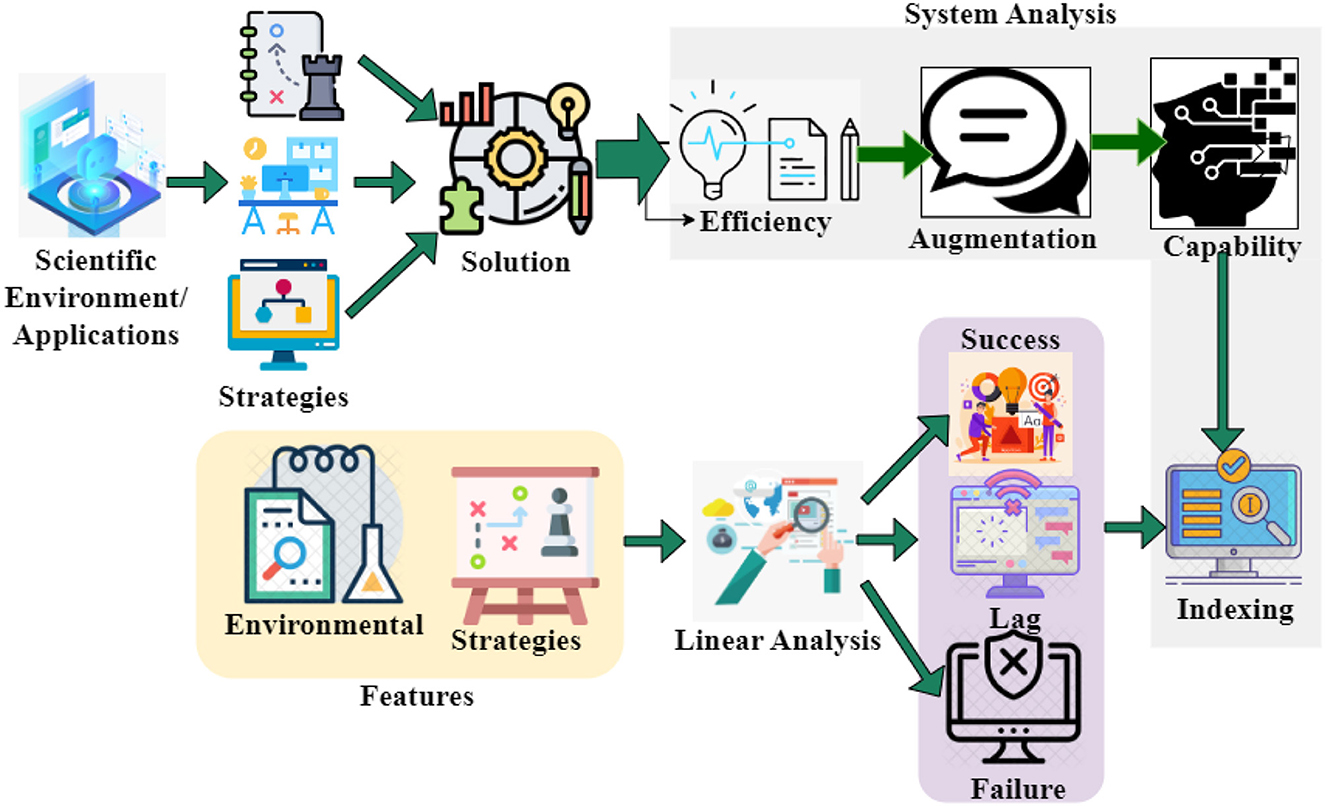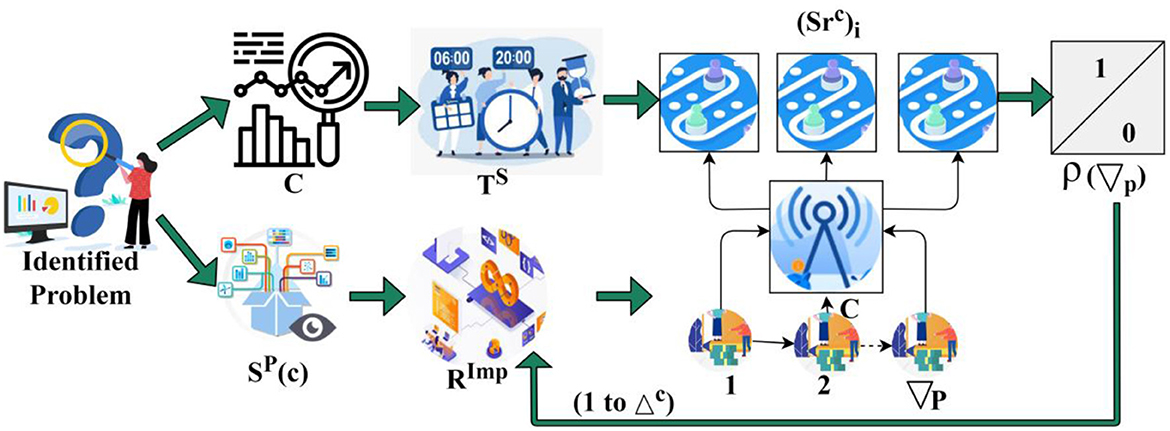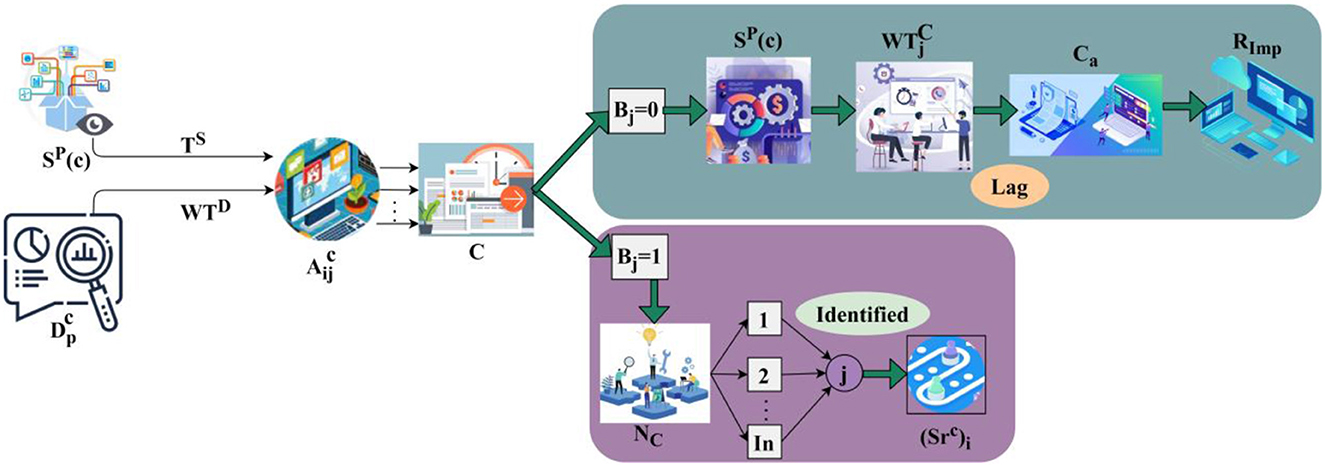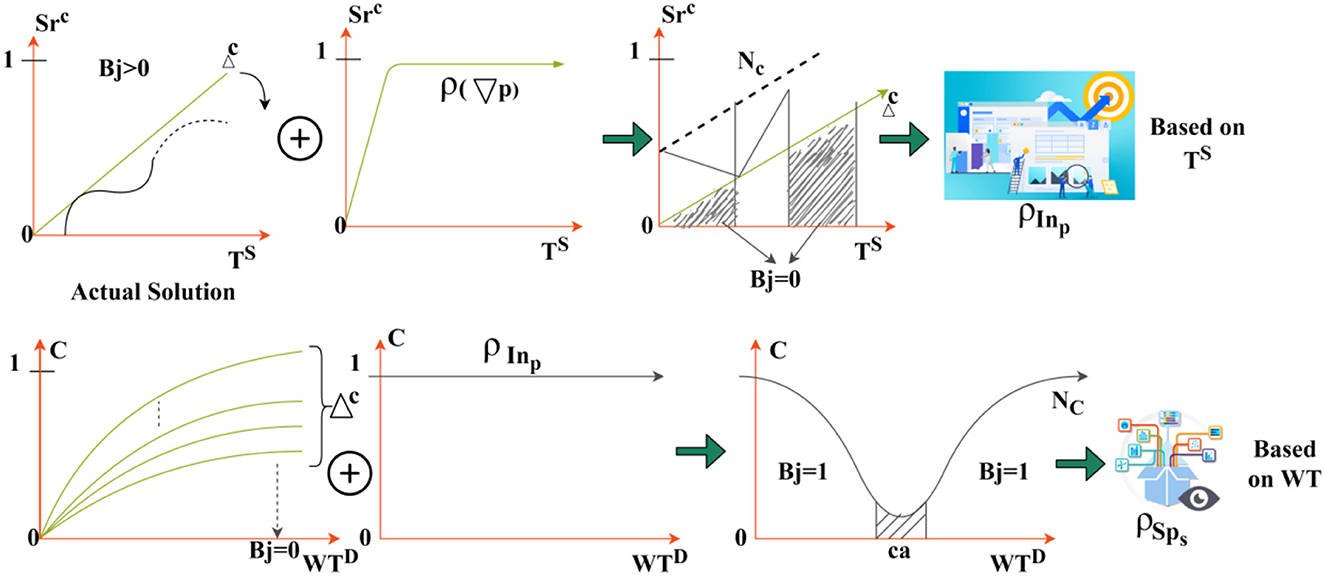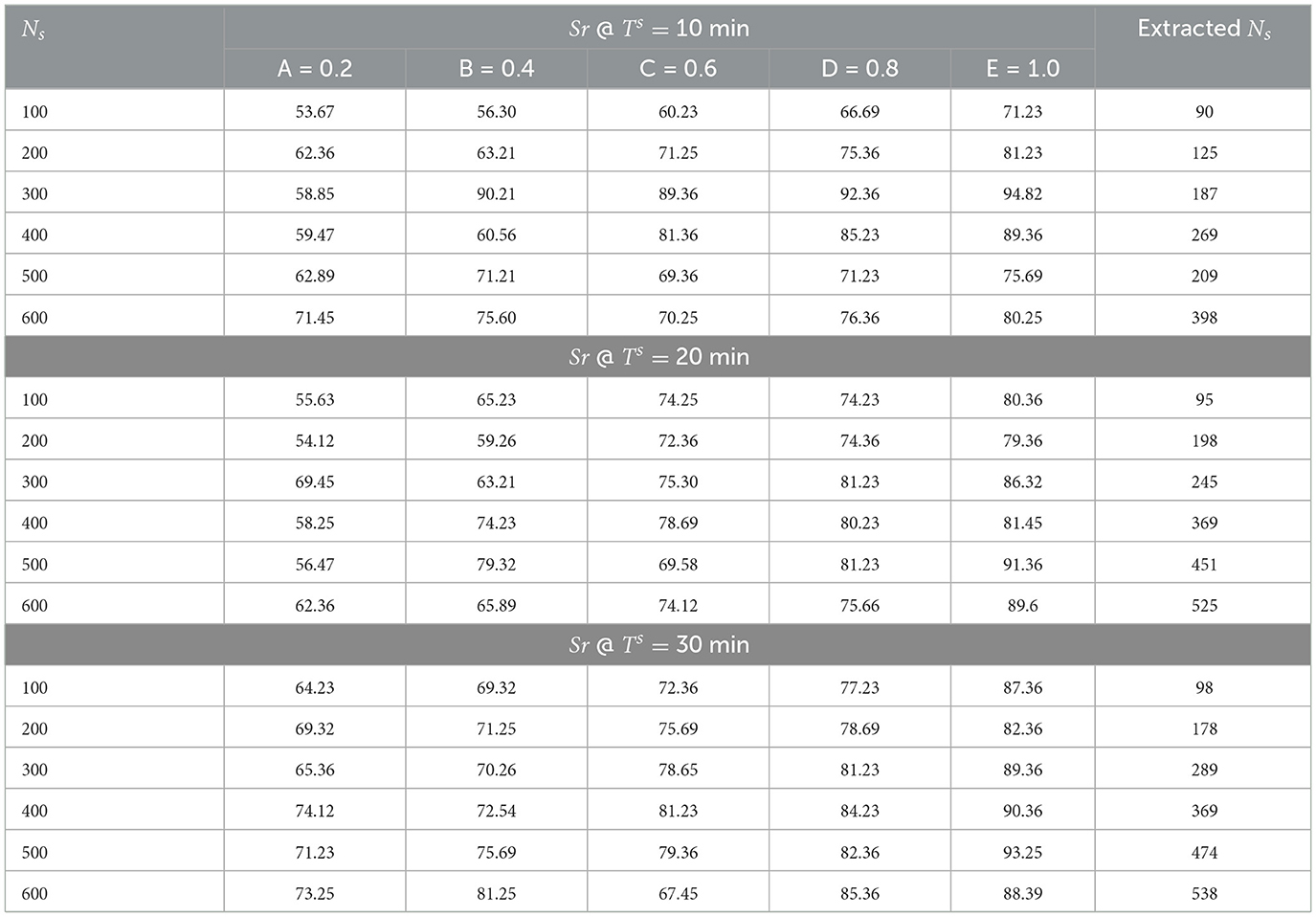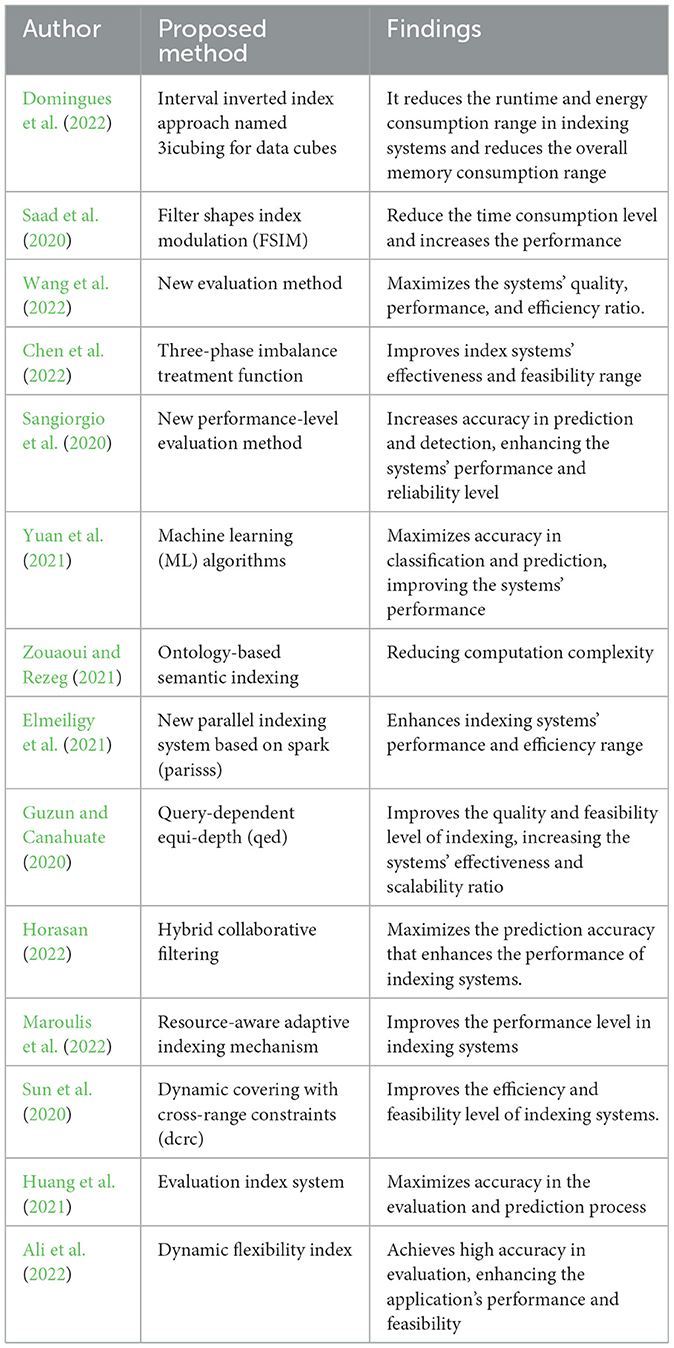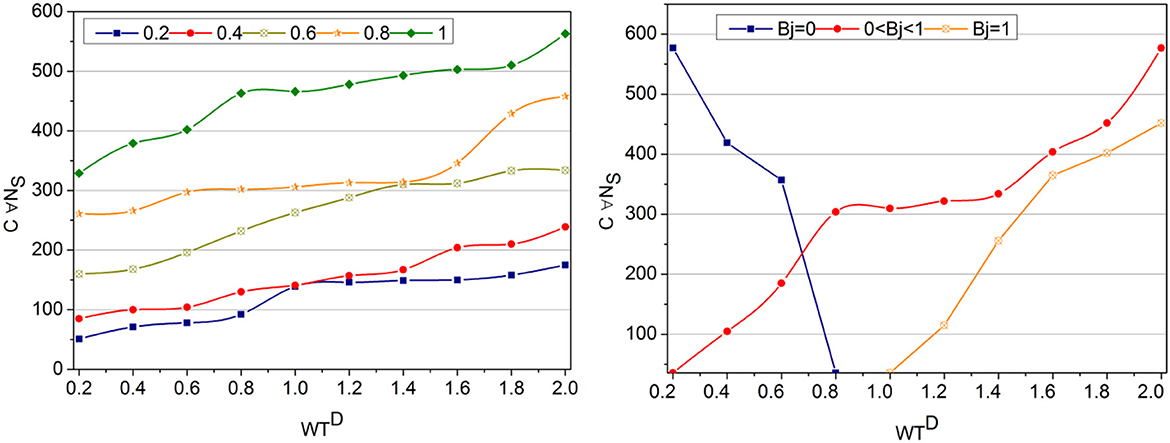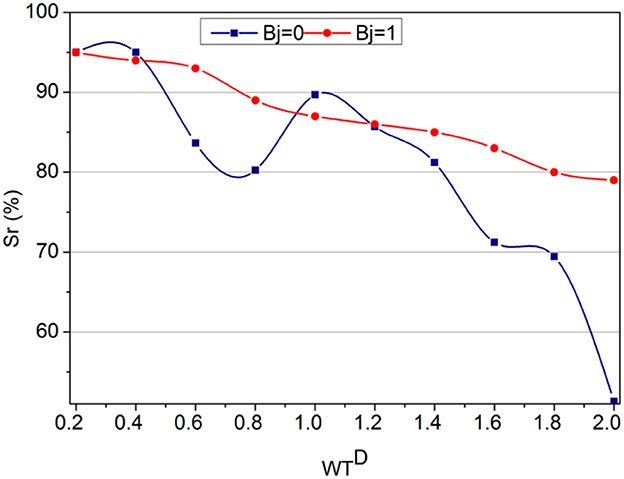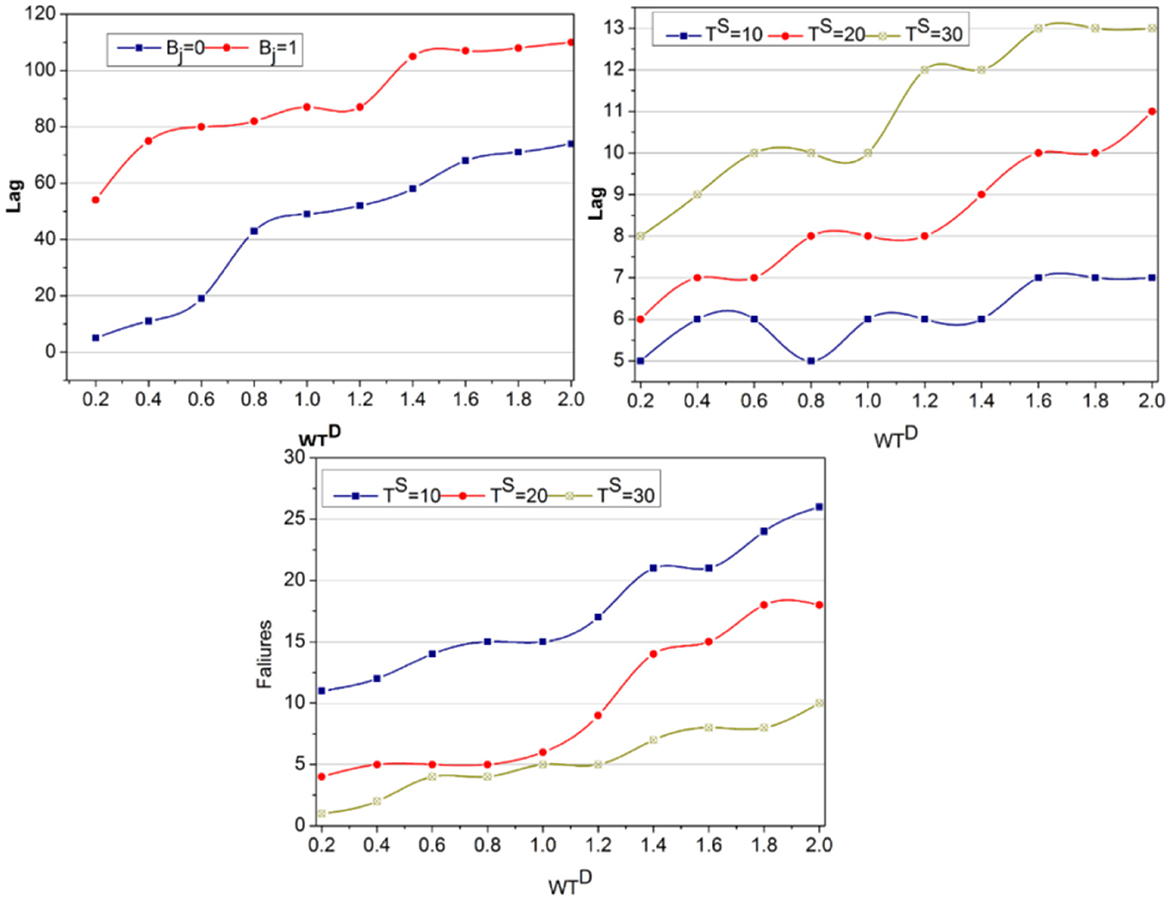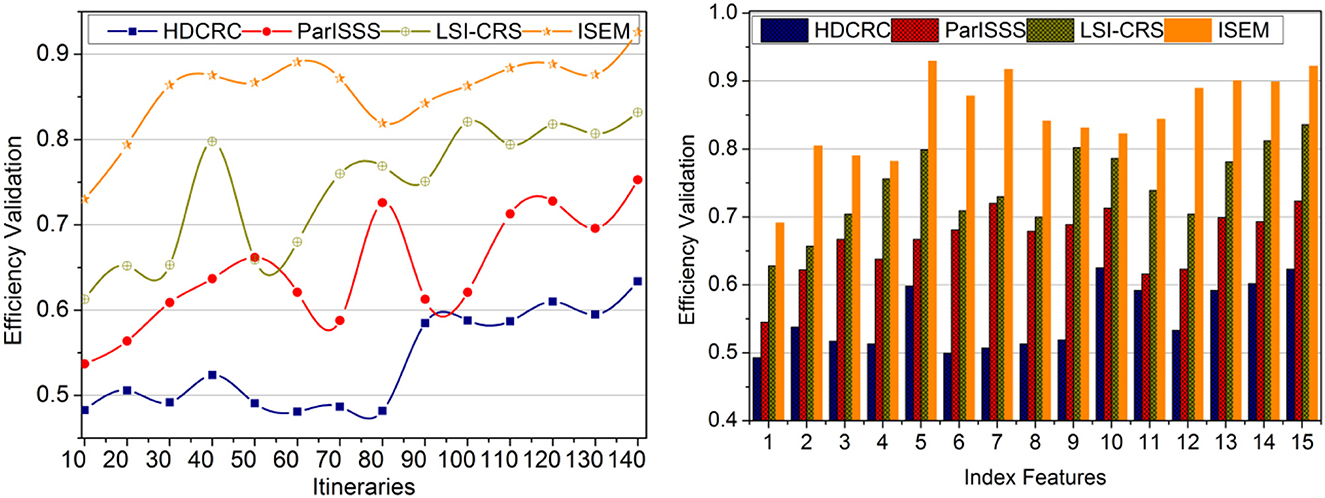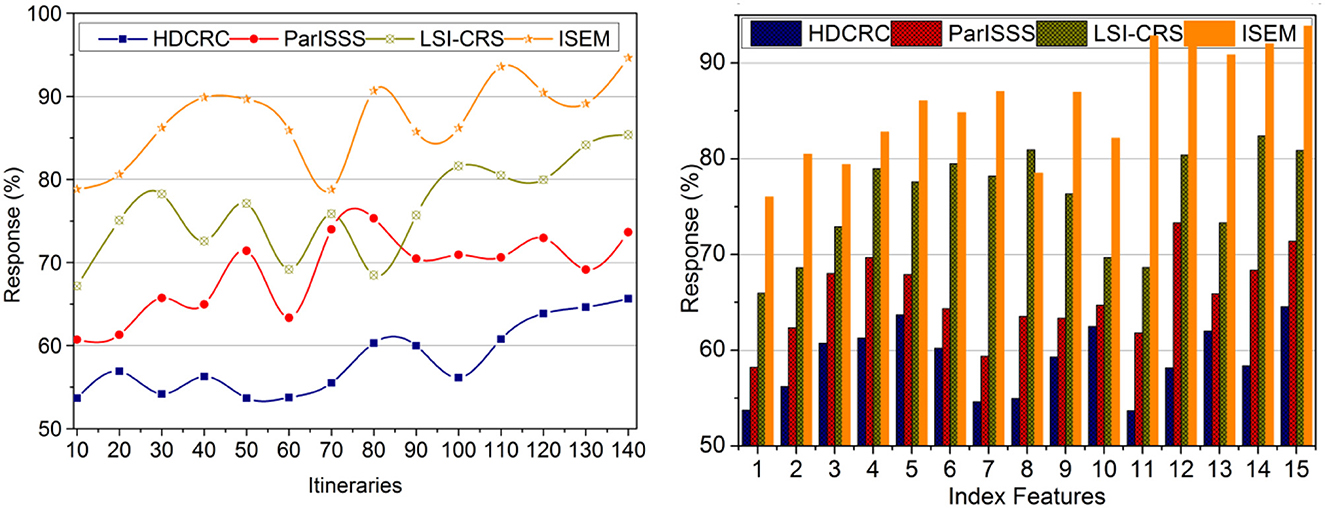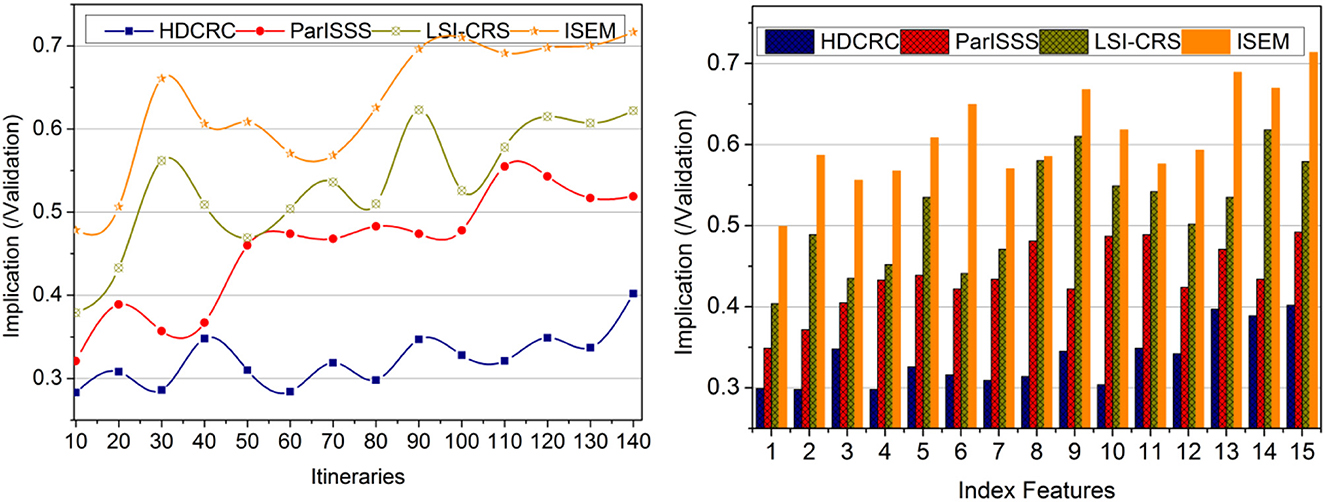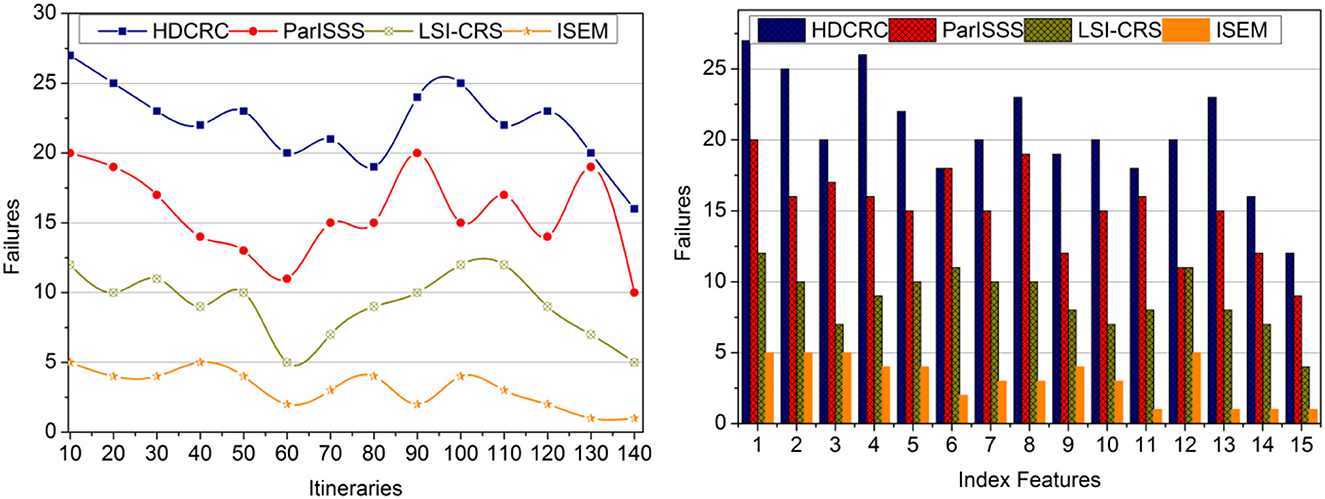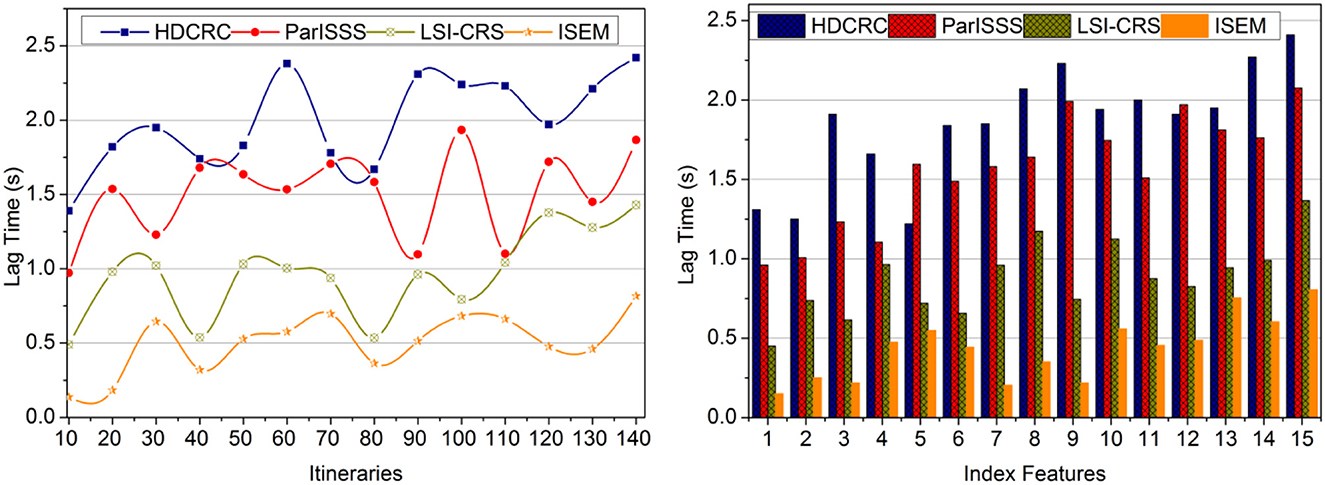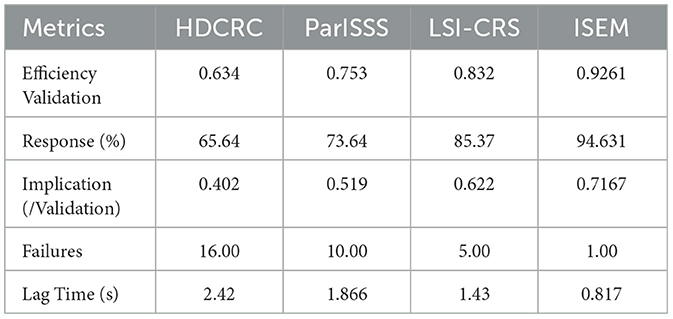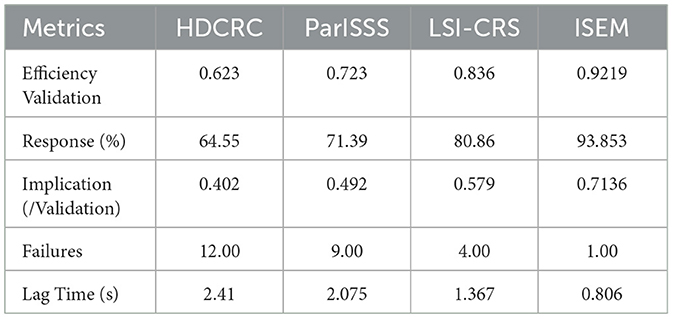- 1School of Economics, Management and Law, Hubei Normal University, Huangshi, Hubei, China
- 2Jiyang College of Zhejiang A&F University, Zhuji, Zhejiang, China
Introduction: A complex scientific environment requires multiple considerations for handling critical and emergency conditions with an addressing solution. Indexing and prioritizing are standard methods that are used in such settings to improve itinerary solutions. Significance of an indexing system relies on the benchmark solution and the strategy it implies.
Methods: The present study introduces an indexing strategy evaluation method (ISEM) to validate the efficiency of indexing systems. The proposed method identifies the root implication and the strategy parameters to address complex problems. The environmental and problem-specific parameters are determined to estimate the system's initial response. The capability through solution response, lag, and failure analysis is identified post the estimation through linear regression learning. The indexing system's operations are designed through linear itineraries to prevent interrupting failures. In addition, the environmental features are identified as augmenting factors to prevent strategy pausing across multiple indices.
Results and discussion: The proposed method employs linear analysis through itinerary levels of index evaluation for optimal, lagging, and failed implications. It also helps to identify specific reasons for solution improvement or retention from previous operations.
Introduction
Emergency management is an organization that gathers resources to deal with all humanitarian aspects and disasters. The main aim of this emergency management is to prevent harmful effects from wreaking havoc during disasters. Emergency management provides various disaster management schemes to ward off people from attacks and other natural calamities (Deng et al., 2015; Amon et al., 2022). Emergency management in a scientific environment is a crucial and complicated task in every disaster management system. Specific education and studies are provided to students to gain more knowledge about emergency management (Sjostrom et al., 2021). Education provides optimal information relevant to the disaster and reduces the complexity range in the prevention process. The scientific environment contains certain aspects that cause severe disasters and accidents (Carapuço et al., 2021). A combination of both traditional and modern skills is required to operate such emergency management systems. Traditional skills provide responsible content, thereby reducing the computation time and energy consumption ratio in delivering preventive services to people. Emergency management capability requires accurate information, which maximizes accuracy in the decision-making process. Therefore, emergency management improves the performance and feasibility range of the scientific environment (Jena et al., 2022; Prabhishek et al., 2022).
An indexing system is a process method that organizes documents or contents based on priorities and concepts. An indexing system is mainly used in various fields to manage tasks based on specific functions and patterns. An indexing system is also used for emergency management (Liu et al., 2021). Emergency management, in turn, requires a proper management system to maintain the database and studies. The indexing system is mainly used for classification and segmentation (Olma et al., 2020). The actual goals of the indexing system for emergency management are mitigation, preparedness, response, prevention, and recovery. A specific set of features and patterns are analyzed by an indexing system that provides relevant data to further emergency services (Toepfer and Seifert, 2020). Indexing system reduces both time and energy consumption range in computation, thereby enhancing the efficiency of emergency management systems. A processing framework based on an indexing system is used in emergency management that identifies important patterns and factors (Wellenzohn et al., 2022). The processing framework is widely used for online emergency management systems. It first understands the exact emergency content that is provided by the user and indices it based on conditions. Social media data are used here to provide the necessary information for such emergency management systems (Paludo Licks et al., 2020).
The indexing system evaluation process uses machine learning (ML) techniques. The ML technique is mainly used here to improve the accuracy of prediction and evaluation processes. Indexing systems require accurate data provided by the evaluation process (Bu et al., 2021). The deep reinforcement learning (DRL) algorithm is mainly used for evaluation. The feature extraction method in DRL extracts the essential features, factors, and patterns relevant to the indexing system. DRL evaluates emergency management systems' content and the indexing accuracy (Wortman and Chandy, 2020). A deep neural network (DNN) is also used in the evaluation, which helps to predict the exact features of an indexing system. Logistics regression is used in DNN, which indicates the risk indexing content presented in the database. DNN maximizes the accuracy in evaluation that enhances the performance and efficiency ratio of systems. DNN also reduces latency and error range in the evaluation process, thereby improving the feasibility of emergency management systems (Wortman and Chandy, 2020; Ning et al., 2022). Multiple linear regression (MLR) is used in emergency management to identify the exact indexing patterns for different processes. In addition, MLR predicts the relevant characteristics and variables of the contents (Dazzi and Mordacchini, 2020).
Related works
Domingues et al. (2022) proposed a new interval inverted index approach, named 3icubing, to data cubes. The main aim of the proposed system is to provide feasible indexing and cubing. Indexation and querying operations are identified from real-time datasets that provide relevant indexing information. The proposed approach reduces the runtime and energy consumption range in indexing systems and the overall memory consumption range in the index representation process.
Saad et al. (2020) designed a filter shape index modulation (FSIM) based on the filter domain for index modulation (IM). FSIM allows the system to gain more spectral efficiency (SE). The proposed FSIM is also used in single-input single-output (SISO) systems that reduce the time consumption level in specific tasks. Experimental results show that the proposed FSIM approach increases the performance and SE of the IM systems.
Wang et al. (2022) developed a new evaluation method for a performance index system. The main aim of the proposed method is to improve the performance level of the index system. A practical evaluation approach addresses the navigation confrontation for the index system construction process. Furthermore, index systems provide relevant data that are required for indexing and evaluation processes. Therefore, this approach maximizes the system's quality, performance, and efficiency ratio.
Using commutation control, Chen et al. (2022) developed a three-phase imbalance treatment function. The proposed method is mainly used for index evaluation, providing information for analytics and management processes. An improved entropy weight method is used here to identify the load imbalance presented in the indexing system. The proposed evaluation method improves index system's effectiveness and feasibility range compared to other methods.
Sangiorgio et al. (2020) introduced a new performance-level evaluation method for railway transportation systems. The analytic hierarchy process (AHP) is used to predict the safety index of the database. AHP defines the indices that reduce the complexity ratio in the analytic process. In addition, AHP analyzes the data required for the evaluation process, thereby reducing the computation time consumption range. This process increases the accuracy in prediction and detection, thereby enhancing the systems' performance and reliability levels.
Yuan et al. (2021) proposed a detailed evaluation index system for intellectual capital. Machine learning (ML) algorithms are used in evaluation methods to predict the detailed index. In addition, random forest (RF) and support vector machine (SVM) are used here to verify the indices required for different processes. Experimental results show that the proposed method maximizes accuracy in classification and prediction, thereby improving the systems' performance and significance level.
Zouaoui and Rezeg (2021) developed an ontology-based semantic indexing system for the Quranic search engine. The main aim of the proposed approach is to retrieve information based on indices. The proposed system obtains feasible grammatical functions and information from the Quran book, reducing computational complexity. In addition, semantic indexing provides reliable data for prediction and analysis. The developed approach employs a user interface that offers multiple inputs to the search engine.
Elmeiligy et al. (2021) proposed a new parallel indexing system based on spark (ParISSS). The proposed ParISSS is mainly used for the analysis of multidimensional big data. Both reception and representation nodes are detected from the database that provides optimal data for the indexing process. ParISSS reduces the computation time and energy consumption range, thereby reducing the computation cost of the systems. The proposed ParISSS enhances an indexing systems' performance and efficiency range compared with those of other methods.
Guzun and Canahuate (2020) introduced a query-dependent equi-depth (QED) for indexing systems. Distributed and parallel algorithms are used here to identify the features for indexing. Nearest-neighbor (NN) queries are detected from the database, thereby producing relevant data for indexing systems. QED achieves high accuracy in classification and identification processes. The introduced QED improves the quality and feasibility level of indexing, thereby increasing the systems' effectiveness and scalability ratio.
Horasan (2022) designed a hybrid collaborative filtering using latent semantic indexing (LSI) for recommender systems (RSs). LSI is mainly used to develop user-based and item-based models for indexing. RS provides objects based on user profiles, thereby improving the systems' efficiency. It helps to reduce the complexity range in computation and prediction latency. The proposed model maximizes the prediction accuracy that enhances the performance of indexing systems.
Maroulis et al. (2022) developed a resource-aware adaptive indexing mechanism for in situ data management systems. Visual analysis is used here to identify the in situ scenarios for indexing. Real and synthetic datasets are implemented here, which provide feasible data for queries. Resource-aware indexing systems are run to reduce time and energy consumption range.
Experimental results show that the proposed mechanism improves the performance level in indexing systems.
Sun et al. (2020) proposed a dynamic covering with cross-range constraints (DCRC) for a time series indexing system. An insertion algorithm is used here to develop a new hierarchical DCRC for indexing. Lower and upper bound nodes are detected from the index tree, thereby reducing the complexity range in time series indexing systems. In addition, DCRC reduces the child node requirement, enhancing the systems' performance range. The proposed DCRC improves the efficiency and feasibility level of indexing systems.
Huang et al. (2021) introduced an evaluation index system for the natural gas pipeline network. The proposed system is mainly used to meet user satisfaction to evaluate the indexing factors. The main aim of the proposed system is to classify the user aspects based on specific characteristics and functions. An indicator identifies the demands that users in the gas pipeline network provide. The proposed evaluation method maximizes accuracy in the evaluation and prediction processes.
Ali et al. (2022) developed a dynamic flexibility index for the evaluation process. The analysis is used here to gather the necessary data from the database, providing feasible information for different approaches. As a result, the complexity ratio and time consumption levels in the computation process are reduced, which improves efficiency levels in the evaluation process. Furthermore, compared with other traditional methods, the proposed method achieves high accuracy in evaluation, enhancing the application's performance and feasibility.
Proposed indexing strategy evaluation method
Priority strategy evaluation of index and capability has been analyzed for critical and emergency conditions in the scientific environment, and some strategies for identifying solutions have been planned. Despite strategy solution addressing the complex scientific environment for a better output, verification is performed by computing the root causes and benchmark solutions for determining the maximum availability of location set covering issue based on environmental and problem-specific parameters. The benchmark solution is challenging when used to meet the allocating demands and their strategic features pertaining to emergency services, first alerting fire departments and allocating SDMA and NDMA services to manage the problem. Due to environmental and strategy features, such as input, output, and algorithm processes, for handling emergency conditions and critical situations it is necessary to compute the efficiency of priority indexing through a linear analysis. The objective of indexing and essential emergency management capability in a scientific environment with addressing solutions is sequentially monitored and analyzed for validating the system's response in that location.
Multiple hazards can be considered in the scientific environment, and its emergency service is allocated based on priority indexing. The priority index-wise queued tasks are assigned and processed individually to improve itinerary solutions. In that environment, the location set covering issue due to different model behaviors and server availability maximizes the indexing of the maximum area set covering and allocation model with waiting and queuing times. The emergency management capability is computed for addressing complex problems in a scientific environment through solution response, lag, and failure analysis for reducing interrupting failures. The root implication and environmental strategy parameters with maximum covering and problem capability with constrained priority-wise indexing time for queue length are computed. A continuous monitoring of such an environment prevents interrupting failures and improves the efficiency of indexing systems. Figure 1 presents the proposed ISEM processes.
The scientific environment is sequentially monitored with some strategic features, and associated data are observed from the satellite, wireless sensors, server availability, and behavior in each region. The proposed model operates between monitoring scientific environment for emergencies and its indexing system process to achieve maximum efficiency. In this model, the benchmark solution and strategy parameters for identifying the root implication and computation of strategic parameters are easy ways to satisfy the system's response to address complex situations. Furthermore, the aim of handling critical and emergency management for addressing the location–allocation model and its maximum coverage is to reduce the complexity and increase the waiting and queuing times. The ISEM is used to compute the efficiency of indexing systems and thus reduce lags and failures in such regions. The linear regression learning output is used to classify the environmental strategy features for identifying complex problems with a final output solution and index system efficiency in that environment. An indexing strategy evaluation model is proposed that joins the capability of maximum covering the location with priority indexing theory.
Results from indexing theory
Priority indexing has been computed for analyzing the complex scientific environment's capability of handling critical emergency management. In this priority indexing system, we assume that the strategy features in a complex scientific environment belong to priority class C (C = 1, 2, …, c). The priority index of this analysis is smaller than the priority class in such an environment. This model considers it a non-preemptive priority scheduling when low environmental emergencies are not important to handle or process first. Thus, the low-level emergencies will be rejected during service and sent back to the queue. First, the higher-priority emergency conditions are handled. Multiple considerations from priority c may appear on the benchmark solution rate C. Every critical condition in this environment has its emergency service time TS computed independently from the root implication RImp(TS) with strategy parameters SP(C). Here, i+1 refers to determining the allocation function. This model also monitors the Head of Line discipline at each priority level. Communication is forwarded in one direction, as determined by the Head of Line discipline. It is necessary to establish and create continuity between sender and receiver stations before data transfer is required to coordinate half-duplex transmission, which allows data to be delivered in both ways on a network of data communication and not simultaneously. For instance, the average waiting time for priority C for the first emergency service is expressed as in Equations (1a) and (1b),
Where
And
In Equations (2) and (3), the variable is the emergency service rate based on the priority class c for computing itinerary solutions. The interpretation of probability of addressing a complex problem ∇p in such an environment is the fraction of the second process, whereas the server is busy (as long as ρ(∇p)i <1). Identifying emergency conditions in a complex scientific environment takes several minutes. The variable WT0 indicates the average delay that the previous emergency service experienced is analyzed for providing the same service or adding additional features to the service is planned and then computing the following equation which is expressed as,
In Equation (4), represents the second emergency service with the service processing time and waiting time computed. The priority class assignment is illustrated in Figure 2.
The C assignment pursues RImp and c ∀TS in determining a new solution. Depending on c availability and SP(c), the augmentation is decided. Contrarily, the C is allocated for the implied RImp, such that 1 to ∇p is the assigned class for . Hence, the ρ(∇P) is obtained as either 1 or 0, such that the o returning instances are implied with RImp. This implication requires SP(c) and augmenting Δc (Figure 2). The objective is used to minimize interrupting failures; it determines that at least one strategy is planned to achieve success through linear analysis for improving the efficiency of indexing systems.
Problem identification
The framework for a complex problem structure comprises a discrete space, in which critical and emergency conditions, allocating demand, and system's response are maintained. Strategy parameters are used for precise decision-making. Tasks are assumed for each network node, similar to the emergency conditions assigned for providing services. The service call for each emergency condition in that environment is used to perform linear analysis with a processing rate. The complex problem will identify multiple considerations for handling emergency conditions and providing the service. We assume that the strategy solution used to provide maximal location coverage to the allocation demand has been addressed. For this model, the final strategy solution and linear analysis-based indexing output are compared by estimating the problem capability, and average service time is defined as the summation of the emergency service call rates of all allocation demands in such environment which is j.
In Equation (5), is used to denote the determining allocation of demand for addressing solution i in the environment at j for priority-wise C services for indexing systems. If represents the emergency service call rate based on priority indexing C at multiple location–allocation demand points i. For example, indicates the demand allocation point i with waiting time; the number of emergency service calls per unit of time for system's response equals 7% of the total population estimated.
Priority indexing for addressing problem location
The priority indexing for addressing problem location assumes static assignments of output solution to indexing efficiency. This isn't easy in the case of identifying the server locations for identifying a best-afford solution across different scientific systems. From this instance, the two constraints are followed to provide services: First, we have to inform the central authority and gain help from their services in critical situations. Second, each individual can decide to stay or escape in those situations.
In this model, the addressing solution indicates separate allocations for the various priorities based on problems that may or may not coincide with strategy parameters. The demand point for addressing complex issues may be allocated to a new environment at j indexing-based instance in priority-wise and to center C≠j for other priorities. The main goal is to cover most problems in all preferences and provide services. Multiple considerations require various time constraints imposed for different indexing priorities. The proposed model's formulation is expressed as in Equations (6–11),
Such that
Where , the location demand i is allocated to different nearby solutions at j instance based on priority of urgency and critical situation for other cases. The variable Bj = 1 represents the solution at j and 0 for all other cases. The variable denotes the average waiting time for indexing In priority at the closest solution j for gaining precise treatment. Strategy parameters have limits to impose the waiting time for index priority class C. Nc is the number of solutions to be sited in that environment, xi is the problem at location–allocation demand i; In is the set of all demand points for indexing systems, Ca is the critical emergency management capability analysis. The above conditions state that the solution i is allocated to the optimal list and provides service priority-wise. The indexing process is illustrated in Figure 3.
The indexing process relies on two distinct inputs, namely, SP(c) and . These inputs are required for under the common factor, time (i.e.) TS and WTD are independently required. The indexing system thus classifies Bj = 0 or Bj = 1 for SP(c) and Nc, respectively. In the identified process, In ∀ j is the complexity utilized for . In the unidentified process, Ca is required for the new allocation of RImp, such that lag is estimated (Figure 3).
Linear regression learning implication
In this linear analysis, the solution response, lag, and failure are sequentially identified based on RImp×WT with an addressing output solution based on InP index priority estimation. The probability of index priority (ρInp) is processed continuously, which is expressed as,
Where
As per Equations (12) and (13), the complex sequential problem addressed through index system operations and solution response is the probability of location covering such an environment. Therefore, this model has no lag and failure; hence, the precise evaluation index system of emergency conditions in such an environment is estimated as per equations. Therefore, based on the problem capability, the new features are added in ρsRs and the efficiency of index evaluation is expressed as,
In Equation (14), the precise index evaluation for achieving maximum efficiency and the environmental features are augmented as per the services. Waiting time is valid for all the itinerary levels of index estimation for optimal, lagging, and failed implication analysis. The root implication is identified based on the study due to solution improvement or retention from the previous operations. The multiple indices pausing across strategy parameters cause lagging, and failures are reduced through linear regression learning with itinerary layers. The regression analysis for efficiency evaluation is presented in Figure 4.
The linear analysis splits the evaluation for TS and WTD independently without increasing the complexity. In the TS validation, Bj>0 alone is validated for ρ(∇P) such that ρInp is the priority constraint. This linear analysis is performed across the varying TS until RImp(TS) is applied. In the WTD based on linear analysis, the C process is considered for Bj = 1 or Bj = 0 conditions. In this case, the NC is completely utilized for ρSRS for preventing prolonged waiting time (Figure 4). The index evaluation efficiency is analyzed using strategy parameters. The output solution is compared at that WT interval to prevent interrupting failures and lagging in providing a solution. The accurate linear analysis helps to identify a particular reason for a better explanation from the previous operations through the learning paradigm. Hence, identifying root implication and strategy parameters for optimal, lagging, and failed operation analysis is performed to achieve a successful indexing. Contrarily, the final output solution used under conditions where similar strategy features are available serves as the optimal analysis. Therefore, the waiting and processing times for the evaluation of an index system result in lag. Thus, the response of the actual system in the scientific environment identifies the different root implications in itinerary layers with the same strategy features. From the output solution and priority indexing, efficiency toward critical and emergency conditions is analyzed until multiple indices and failures are identified. Here, the processing rate and waiting time are used for validating the efficiency of the index system, at the time some additional strategy features are added for a better solution and decision-making. Therefore, the priority class lagging is identified when matching the best solution with the final output solution through linear regression learning for offering optimal services to the population. This model processes the priority-wise index system operations without increasing the complexity and failures and preventing lagging. Hence, the itinerary solutions based on indexing and priority are computed to improve the indexing system's efficiency and follow new strategy parameters with linear analysis for augmenting the solution. In a complex scientific environment, this present research introduced an indexing strategy evaluation method (ISEM) for multiple considerations to handle critical and emergency conditions with an addressing solution for validating the efficiency of indexing systems.
Performance assessment
The cognitive modeling of complex system datasets (Vitalii, 2022) is exploited to analyze the performance of the proposed method. This dataset provides weights, edges, inputs, and states for achieving the precise target of a complex system. In this system analysis, five different weights (priorities A to E) are assigned for analyzing the proposed method. The linear analysis for system validation using the given dataset is presented in Figure 5.
The weights are assigned at two different controls: testing and strategy. The testing encloses the results across the linear and non-linear analyses. The new weight (priority) type is assigned based on the allocated weights. This step is required to be carried out to prevent failures. Similarly, the lag time between Bj = 1 (weights) and Bj = 0 (weights) is estimated as the lag time. If the actual time exceeds the lag, then it is considered a failure (Figure 5). From the data provided, the linear analysis for TS and WTD is independently performed (as in Figure 4). First, for varying the indexing (A to E), the extracted and actual NS is analyzed in Table 1.
As the prioritization increases in TS, the WTD decreases, for which new augmentation is preferred. If further boost is desired, indexing is varied, and environmental features are considered. Therefore, the consecutive differences in WTD reduce the current capability for which lags are measured. The indefinite lags are pursued to prevent multiple indexing instances (Table 2). The analysis based on the minimum and maximum waiting times is presented in Figures 6, 7.
The analysis of C ∀ NS (ρInp and Bj) and Sr is presented in Figures 6, 7. As the waiting time increases, the need for prioritizing (indexing) increases, and therefore Bj is validated. For the Bj = 1, the C ∀ NS is high compared to 0 <Bj <1; this is contrarily less for Bj = 0. In this case alone, the C ∀ NS drops and hence the Sr (%). Therefore, the Sr(%)dropping for Bj = 1 prolonged, such that the variations are compressed. Post this analysis, the lag and failure of the prolonged TS intervals and WTD are analyzed in Figure 8.
The proposed method achieves less lag and failures; the failures are filtered from the lag within WTD. This is invariable due to the linear analysis from ρ(∇p) perspective, and therefore j from C is increased for and hence Ca is suppressed. Considering the invariable imbalance, the consecutive WTD is confined within the range, and therefore as TS increases failures are less. This indicates that the WTD is achieved (balanced) within a prolonged time (Figure 8). The comparative study uses efficiency validation, response, operation implications, failures, and lag time. The itineraries are between 10 and 140, and the index features are between 1 and 15 in this assessment. The methods of hierarchical dynamic covering with cross-range constraints (HDCRC) (Sun et al., 2020), parallel indexing system based on spark (ParISSS) (Elmeiligy et al., 2021), and latent semantic indexing (LSI) for recommender systems (RS) (LSI-CRS) (Horasan, 2022) are accounted for from the Related Works section in this comparative study.
Efficiency validation
In Figure 9, the priority indexing system operations are evaluated for augmenting the efficiency and capability of identifying critical and emergency conditions in a scientific environment relying on addressing solutions and benchmark solutions. The strategy parameters and benchmark solutions are computed to perform the efficiency validation for addressing complex problems in such an environment. Managing multiple indices across the pausing strategy interrupts failures that simultaneously lead to complex issues with root implications. The monitoring and observing data from the scientific environment are analyzed and compared with previous environmental features. Then, services or first aid are provided to the population for a successive emergency management. The problem-specific parameters are identified and studied for improving the capability of critical emergency management, whereas the complex problem causing lagging and failure is identified through linear regression learning. The lag in strategy solution is addressed through linear analysis for maximizing the response of the system to the condition C = 1 and C∈{0, 1} satisfies successive itinerary solutions. In this article, strategy solution and index system evaluation are the essential factors that prevent lagging under waiting time. Hence, priority-wise, the complex problems will handle and allocate locations for service outputs in high index efficiency validation due to maximum capacity through a system's response.
Response
The environmental features and problem-specific parameters rely on benchmark solutions, and some strategies to identify the importance of indexing system in the proposed model are presented in Figure 10. The non-preemptive priority scheduling-based problem-solving model satisfies a high system's response by applying the root implication and strategy parameters to address complex problems through a linear analysis. In this manner, the current environmental features are identified in itinerary layers at issue addressing time, preventing the waiting time for allocating location to gain services in that place. Critical and emergency management is handled to manage the location–allocation model and its increasing covering location to reduce service failures and the waiting and processing time. The lagging in the priority index system is analyzed to improve system response with strategy parameters, which helps to identify multiple indices under waiting time. The environmental features are identified and augmenting the parameters for estimation of the maximum indexing efficiency. Therefore, the addressing solution is computed to maximize the efficiency of index systems through linear analysis using learning results in a high solution response.
Operation implications
The proposed model achieves high operation implications in complex scientific environments relying on addressing solutions with multiple indices, and the output solution is compared to the best solution. The root implication is aided for augmenting the emergency management capability with a priority indexing system, in which the environmental factor changes are identified for a successive itinerary solution, as depicted in Figure 11. The lagging in indexing operation and waiting time is mitigated due to the handling of higher-priority emergency conditions. Multiple considerations from priority c may appear to compute the benchmark solution rate C and waiting time. The operation implication is identified for addressing the complex problem and maximizing linear analysis through itinerary levels to reduce interrupting failures simultaneously. The problematic issue will be determined based on multiple considerations and then decided to provide service. Observing people in a critical situation is identified through varying environmental features and linear regression learning for allocating nearby healthcare centers to gain benefit during emergency times. For instance, let us compare the final output solution with efficiency validation to compute the best key in that condition. Contrarily, the solution response increases at the initial stage of designing the index system operations and employs linear analysis with other factors. Therefore, the operation implication is high, and the capability is also increased.
Failures
The ISEM that uses a linear analysis to compute multiple considerations or responses for successful solutions in the complex scientific environment under waiting time is illustrated in Figure 12. This proposed model satisfies fewer interrupting failures by validating the continuous index system operations depending on varying environmental features at different time intervals and scrutinizes the solution response. In this article, based on the indexing system priority-wise, the problems are analyzed for defining the allocation of demand for addressing solution i in such environment at j for priority-wise C services for indexing systems. Augmenting factors aid the ISEM and increase the index system's operation efficiency for addressing complex problems. The multiple indices are identified in the strategy parameters through linear regression learning until achieving the maximum efficiency validation. The addressing demand point in that complex problem may or may not be allocated location to a healthcare center at j indexing instance based on priority-wise indexing system and to center C≠j for other priorities. Therefore, the interrupting failure is less than this model's other factors.
Lag time
In Figure 13, the increasing output solution and system response result in high lag time and waiting time for an index system's operation through linear analysis to identify complex problems in the scientific environment. The maximum efficiency and capability of critical emergency management contain less lag time and failure at any interval with an addressing solution. The solution response, lag, and loss are computed continuously with RImp×WT to estimate the best solution based on InP index priority estimation. The available output solution and strategy parameters are considered for improving the capability of critical emergency management. Therefore, there is a high lag, and failures are identified when addressing the complex problem in that environment. Hence, the precise evaluation index system of emergency conditions is estimated as per the above condition. The multiple indices pausing across different environmental features cause lagging, and failures are reduced through linear regression learning along with itinerary layers, preventing lag time. The optimal analysis is the final output solution for conditions where similar strategy features are available. Therefore, the waiting and processing time for index system evaluation results in less lag time. This study is summarized in Table 3 (Itineraries) and Table 4 (Index features).
The proposed ISEM improves efficiency validation, response, and implication by 9.32, 9.87, and 10.12%, respectively. In addition, it reduces the failures and lag time by 7.53 and 9.52%, respectively.
The proposed ISEM improves efficiency validation, response, and implication by 9.73, 10.79, and 11.13%, respectively. In addition, it reduces the failures and lag time by 7.33 and 9.78, respectively.
Conclusion
The present study introduced an indexing strategy evaluation method for validating the performance of solution-providing systems in complex scientific environments. This method identifies root implications for providing lag-less and problem-specific solutions. In problem identification and importance, linear regression analysis is employed. First, the indexing system is evaluated by determining the demand allocation and its solution implication with less waiting time. Second, the strategy parameters are verified for their need under probability-based benchmark solutions. This feature is required for identifying lag to failures through linear regression under different service time tenures. In all assignments, the itineraries for solution response (post implication), lag, and losses are identified, for which either a new feature-augmented solution or an existing benchmark solution is provided. The consecutive waiting time suppression between the actual service times instances reduces the recurrent indexing for complex environment handling systems. Therefore, the final probability for a new feature implication is verified across multiple priority classes in extracting the solution. The proposed ISEM improves efficiency validation, response, and importance by 9.73, 10.79, and 11.13% for the varying index features. It reduces the failures and lag time by 7.33 and 9.78%, respectively.
Data availability statement
The original contributions presented in the study are included in the article/supplementary material, further inquiries can be directed to the corresponding author.
Author contributions
XZ: writing—original draft preparation. ZH: editing data curation and supervision. Both authors contributed to the article and approved the submitted version.
Funding
This work was supported by Hubei Normal University Scientific Research Innovation Team Plans (2019CP01), Special Soft Science Research on Talents and Services of Technology Innovation in Hubei Province (2022EDA096), Youth Fund Project of Philosophy and Social Science of Universities in Hubei Province (21Q165), Teaching Reform Research Project of Hubei Normal University in 2018 (2018027), Ideological and Political Demonstration Course of Hubei Normal University in 2021 (KCSZ202102), Teaching Reform Research Project of Hubei Normal University in 2022 (2022008), Teaching and Research Project of Higher Education Institutions in Hubei Province in 2022 (2022353), Innovation and Entrepreneurship Training Program Project of College Student in 2022 (D202205031309141951), Undergraduate Research Projects of Hubei Normal University in 2022 (2022006) (XZ), and the Jiyang College of Zhejiang A&F University under Grant No. RC2021A03 (ZH).
Conflict of interest
The authors declare that the research was conducted in the absence of any commercial or financial relationships that could be construed as a potential conflict of interest.
Publisher's note
All claims expressed in this article are solely those of the authors and do not necessarily represent those of their affiliated organizations, or those of the publisher, the editors and the reviewers. Any product that may be evaluated in this article, or claim that may be made by its manufacturer, is not guaranteed or endorsed by the publisher.
References
Ali, S. M., Chang, C. T., and Chang, J. S. (2022). Application of dynamic flexibility index for evaluation of process control system designs. Comput. Chem. Eng. 166, 107988. doi: 10.1016/j.compchemeng.2022.107988
Amon, D. J., Gollner, S., Morato, T., Smith, C. R., Chen, C., Christiansen, S., and Pickens, C. (2022). Assessment of scientific gaps related to the effective environmental management of deep-seabed mining. Marine Policy 138, 105006. doi: 10.1016/j.marpol.2022.105006
Bu, H., Dong, M. K., Yi, J. F., Zang, B. Y., and Chen, H. B. (2021). Revisiting persistent indexing structures on Intel Optane DC persistent memory. J. Comput. Sci. Technol. 36, 140–157. doi: 10.1007/s11390-020-9871-0
Carapuço, M. M., Taborda, R., Andrade, C., and de Jonge, V. N. (2021). How to foster scientific knowledge integration in coastal management. Ocean Coastal Manage. 209, 105661. doi: 10.1016/j.ocecoaman.2021.105661
Chen, J., Zhou, F., Gu, L., Yin, H., Zhang, L., and Gao, C. (2022). Evaluation index and evaluation method of three-phase imbalance treatment effect based on commutation. IEEE Access 10, 101913–101921. doi: 10.1109/ACCESS.2022.3208910
Dazzi, P., and Mordacchini, M. (2020). Scalable decentralized indexing and querying of multi-streams in the fog. J. Grid Computing 18, 395–418. doi: 10.1007/s10723-020-09521-3
Deng, K., Ren, K., Zhu, M., and Song, J. (2015). A data and task co-scheduling algorithm for scientific cloud workflows. IEEE Trans. Cloud Computing 8, 349–362. doi: 10.1109/TCC.2015.2511745
Domingues, M., Silva, R. R., and Bernardino, J. (2022). Cubing: an interval inverted index approach to data cubes. IEEE Access 10, 8449–8461. doi: 10.1109/ACCESS.2022.3142449
Elmeiligy, M. A., Desouky, A. I. E., and Elghamrawy, S. M. (2021). An efficient parallel indexing structure for multi-dimensional big data using spark. J. Supercomputing 77, 11187–11214. doi: 10.1007/s11227-021-03718-3
Guzun, G., and Canahuate, G. (2020). High-dimensional similarity searches using query driven dynamic quantization and distributed indexing. Distributed Parallel Databases 38, 255–286. doi: 10.1007/s10619-019-07266-x
Horasan, F. (2022). Latent semantic indexing-based hybrid collaborative filtering for recommender systems. Arab. J. Sci. Eng. 1–15. doi: 10.1007/s13369-022-06704-w
Huang, W., Li, Y., Yu, W., Yu, H., Shan, X., Wang, H., and Gong, J. (2021). An evaluation index system of the user satisfaction for the natural gas pipeline network. J. Pipeline Sci. Eng. 1, 452–458. doi: 10.1016/j.jpse.2021.11.001
Jena, K. K., Bhoi, S. K., and Prasad, M. (2022). A fuzzy rule-based efficient hospital bed management approach for coronavirus disease-19 infected patients. Neural Comput and Applic. 34, 11361–11382. doi: 10.1007/s00521-021-05719-y
Liu, J., Goel, A., Kua, H. W., Wang, C. H., and Peng, Y. H. (2021). Evaluating the urban metabolism sustainability of municipal solid waste management system: an extended exergy accounting and indexing perspective. Applied Energ 300, 117254. doi: 10.1016/j.apenergy.2021.117254
Maroulis, S., Bikakis, N., Papastefanatos, G., Vassiliadis, P., and Vassiliou, Y. (2022). Resource-aware adaptive indexing for in situ visual exploration and analytics. The VLDB J. 32, 1–29. doi: 10.1007/s00778-022-00739-z
Olma, M., Karpathiotakis, M., Alagiannis, I., Athanassoulis, M., and Ailamaki, A. (2020). Adaptive partitioning and indexing for in situ query processing. The VLDB J. 29, 569–591. doi: 10.1007/s00778-019-00580-x
Paludo Licks, G., Colleoni Couto, J., de Fátima Miehe, P., De Paris, R., Dubugras Ruiz, D., and Meneguzzi, F. (2020). SMARTIX: a database indexing agent based on reinforcement learning. Appl Int. 50, 2575–2588. doi: 10.1007/s10489-020-01674-8
Prabhishek, S., Achyut, S., and Manoj, D. (2022). Review on nontraditional perspectives of synthetic aperture radar image despeckling. J. Electronic Imaging 32:1609. doi: 10.1117/1.JEI.32.2.021609
Saad, M., Palicot, J., Bader, F., Al Ghouwayel, A. C., and Hijazi, H. (2020). A novel index modulation dimension based on filter domain: filter shapes index modulation. IEEE Trans. Commun. 69, 1445–1461. doi: 10.1109/TCOMM.2020.3039842
Sangiorgio, V., Mangini, A. M., and Precchiazzi, I. (2020). A new index to evaluate the safety performance level of railway transportation systems. Safety Sci. 131, 104921. doi: 10.1016/j.ssci.2020.104921
Sjostrom, A. J., Ciannelli, L., Conway, F., and Wakefield, W. W. (2021). Gathering local ecological knowledge to augment scientific and management understanding of a living coastal resource: the case of Oregon's nearshore groundfish trawl fishery. Marine Policy 131, 104617. doi: 10.1016/j.marpol.2021.104617
Sun, T., Liu, H., McLoone, S., Ji, S., and Wu, X. (2020). Time series indexing by dynamic covering with cross-range constraints. The VLDB J. 29, 1365–1384. doi: 10.1007/s00778-020-00614-9
Toepfer, M., and Seifert, C. (2020). Fusion architectures for automatic subject indexing under concept drift. Int. J. Digital Libraries 21, 169–189. doi: 10.1007/s00799-018-0240-3
Vitalii, M. (2022). Cognitive Modeling of Complex. Available online at: https://www.kaggle.com/datasets/vbmokin/cognitive-modeling-of-complex-systems (accessed December 7, 2022).
Wang, Y., Sun, F., Wang, X., Hao, J., and Liu, W. (2022). Construction of the performance index system of navigation confrontation and research on its related evaluation methods. IEEE Trans. Inst. Measurement. 71, 1–16. doi: 10.1109/TIM.2022.3170877
Wellenzohn, K., Böhlen, M. H., Helmer, S., Pietri, A., and Zacchiroli, S. (2022). Robust and scalable content-and-structure indexing. The VLDB J. 15, 1–27. doi: 10.1007/s00778-022-00764-y
Wortman, P. A., and Chandy, J. A. (2020). A framework for evaluating security risk in system design. Discov Internet Things 2, 7. doi: 10.1007/s43926-022-00027-w
X. Ning, W., and Tian, Z. Yu. (2022). HCFNN: high-order coverage function neural network for image classification. Pattern Recognition. 131, 108873. doi: 10.1016/j.patcog.2022.108873
Yuan, B., Xia, H., and Guo, C. (2021). An evaluation index system for intellectual capital evaluation based on machine learning. Alexandria Eng. J. 60, 1519–1524. doi: 10.1016/j.aej.2020.11.006
Keywords: emergency management, index system, linear analysis, scientific environment, indexing strategy evaluation method
Citation: Zhao X and Hu Z (2023) Research on an evaluation index system of critical emergency management capability based on machine learning in a complex scientific environment. Front. Ecol. Evol. 11:1176872. doi: 10.3389/fevo.2023.1176872
Received: 01 March 2023; Accepted: 13 April 2023;
Published: 15 May 2023.
Edited by:
Xin Ning, Institute of Semiconductors (CAS), ChinaCopyright © 2023 Zhao and Hu. This is an open-access article distributed under the terms of the Creative Commons Attribution License (CC BY). The use, distribution or reproduction in other forums is permitted, provided the original author(s) and the copyright owner(s) are credited and that the original publication in this journal is cited, in accordance with accepted academic practice. No use, distribution or reproduction is permitted which does not comply with these terms.
*Correspondence: Zhenlong Hu, aHV6aGVubG9uZzIwMjFAMTYzLmNvbQ==
 Xianli Zhao
Xianli Zhao Zhenlong Hu
Zhenlong Hu